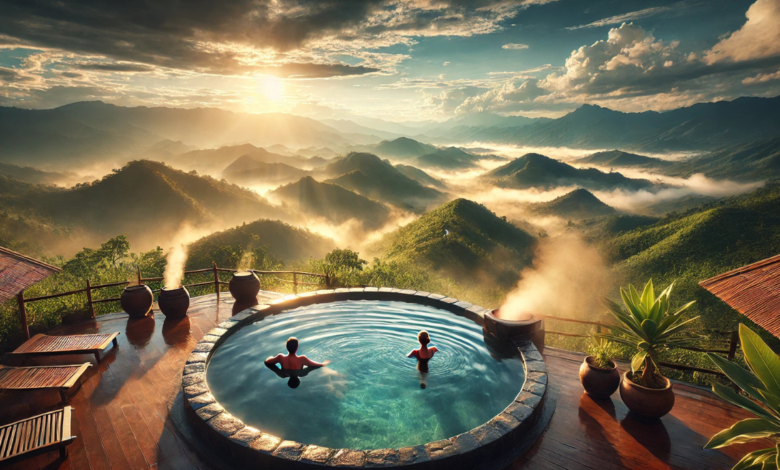Discovering the Tranquil Bliss of Hilltop Hot Springs: A Guide to Rejuvenation

Hot springs have long been celebrated for their healing properties, with visitors flocking to these natural wonders for relaxation, rejuvenation, and health benefits. While many hot springs exist, hilltop hot springs offer a unique experience that combines natural therapeutic benefits with breathtaking panoramic views. Imagine soaking in warm, mineral-rich waters surrounded by mountains, forests, and the beauty of the great outdoors. This guide will take you through everything you need to know about hilltop hot springs, from their health benefits to some of the best destinations worldwide and how to plan your visit.
What Are Hilltop Hot Springs?
Hilltop hot springs are geothermal springs located at higher elevations, often perched on the side of mountains or atop hills. They offer visitors an elevated experience, both literally and figuratively. These springs are formed when geothermally heated water rises from deep underground, typically carrying minerals like sulfur, calcium, and magnesium. As the water reaches the surface, it often finds its way to natural pools, creating serene settings for those seeking a relaxing escape.
The difference between hilltop and other hot springs lies primarily in their location. While many hot springs are found at lower elevations, hilltop hot springs are situated in more remote, elevated areas, often resulting in stunning vistas and more secluded, peaceful environments. Whether relaxing in a public hot spring in a mountainous region or enjoying the privacy of a luxury resort perched on a hill, the views and ambience of hilltop hot springs set them apart from typical hot spring experiences.
Hilltop hot springs offer more than relaxation—they provide a unique way to connect with nature. Their elevated locations often bring cooler temperatures and fresh air, allowing a refreshing contrast to the warm, soothing water. Whether you’re visiting a natural spring in a remote area or a luxury resort in the mountains, the serenity of these locations enhances the healing experience.
Health Benefits of Visiting Hilltop Hot Springs
Hilltop hot springs are renowned for their healing properties, offering numerous health benefits for the body and mind. The warm waters relax muscles, ease joint pain, and promote physical well-being. Soaking in these mineral-rich pools can help alleviate the discomfort of arthritis, sore muscles, and even chronic pain. The minerals in the water, such as sulfur and magnesium, are absorbed through the skin, providing therapeutic effects that support healthy skin and muscle recovery.
Beyond physical health, hilltop hot springs are also a powerful tool for mental wellness. The soothing warmth of the water, combined with the tranquil surroundings, promotes stress relief and relaxation. Taking time to soak in a hilltop hot spring allows the body to release tension, reduce anxiety, improve sleep, and enhance overall mood. The calming effect of the water is also great for clearing the mind and reducing mental fatigue. After a long day of travel, hiking, or working, these natural hot springs offer a perfect way to unwind.
Research has shown that the minerals found in hot springs can positively affect blood circulation and cardiovascular health. Soaking in hot springs increases blood flow, which can help deliver oxygen and nutrients to tissues and organs, promoting healing and recovery. Regular visits to hilltop hot springs can also boost the immune system, leaving visitors feeling refreshed, rejuvenated, and ready to take on whatever comes next.
The Best Hilltop Hot Springs Around the World
Many hilltop hot springs are scattered around the world, each offering a unique experience with its charm and appeal. One of the most famous is found in Iceland, where the Blue Lagoon sits on a lava field. This iconic hot spring is known for its stunning blue waters, rich in silica, sulfur, and minerals. Surrounded by mountains, the Blue Lagoon offers a spa-like experience with luxurious amenities, making it a must-visit for those travelling to Iceland.
Japan also boasts several hilltop hot springs, with the Hakone area being one of the most popular regions. Located just outside Tokyo, Hakone features numerous hot spring resorts among the scenic mountains. Many of these resorts offer outdoor baths with views of Mount Fuji, making them a perfect choice for visitors seeking a blend of relaxation and natural beauty.
In the United States, Mammoth Lakes in California is home to some of the most famous hilltop hot springs in the Sierra Nevada mountains. The area’s wild, unspoiled nature provides a serene atmosphere for those looking to soak in natural, mineral-rich waters while enjoying views of snow-capped peaks. Other notable hilltop hot springs in the U.S. include those in Colorado and the hot springs in the Cascade Range.
For those looking for something more remote, Termas Geométricas in Chile is an extraordinary hot spring destination in the Andes mountains. The resort features a network of outdoor thermal pools amidst the dramatic mountain landscape. Visitors can relax in the geothermal waters surrounded by lush forests and towering peaks, offering an unforgettable natural experience.
Planning Your Visit to Hilltop Hot Springs
When planning a visit to hilltop hot springs, several factors must be considered to make the experience as enjoyable and comfortable as possible. First, the best time to visit can vary depending on the location. In general, it’s best to visit during the spring or fall when the weather is mild, and the hot springs aren’t overcrowded. Winter can also be a magical time to visit, especially in regions with snow-capped mountains, though you may need to plan for colder temperatures.
It’s also important to consider what to pack for your visit. While swimwear is essential, don’t forget to bring a towel, sunscreen, and water shoes to protect your feet in the rocky or uneven terrain around the springs. Depending on the location, you may want to pack warm clothing, as the air can be chilly, especially in the evening or at higher elevations.
Accessibility can be a consideration, as some hilltop hot springs are located in remote, rugged areas. Check for transportation options and accessibility features before you go, especially if you have mobility concerns. Many hot spring resorts offer shuttle services, but remote locations may require hiking or off-road vehicles.
When soaking in the hot springs, remember to stay hydrated and avoid staying in the water for too long. Respect the environment and local communities. Always follow guidelines for responsible behaviour in natural settings, and clean up after yourself to keep these beautiful places pristine for others to enjoy.
Conclusion
Hilltop hot springs are a unique and rejuvenating experience that benefits physical and mental health. From the soothing mineral-rich waters to the tranquil surroundings and panoramic views, these hot springs provide the perfect environment for relaxation and healing. Whether you’re soaking in a famous spring in Iceland, Japan, or California or venturing to a more remote location like Termas Geométricas in Chile, hilltop hot springs are an unforgettable way to reconnect with nature.
Frequently Asked Questions (FAQs)
Are hilltop hot springs safe for everyone?
While hilltop hot springs are generally safe, it’s essential to consult with a healthcare professional before visiting if you have any pre-existing health conditions, such as heart disease, skin sensitivities, or pregnancy.
What is the best time to visit hilltop hot springs?
The best time to visit is typically in the spring or fall when temperatures are mild. However, each destination may have its peak season, so consider checking the local climate and tourism trends.
Can hilltop hot springs be visited year-round?
Many hilltop hot springs can be visited year-round, but accessibility may vary based on weather conditions, especially in mountainous areas that experience heavy snowfall.
Do I need to make reservations in advance?
Making reservations in advance, especially during peak seasons, is highly recommended for popular destinations to ensure availability and avoid overcrowding.
What should I bring to a hilltop hot spring?
Bring swimwear, a towel, sunscreen, water shoes, and other personal items, such as a camera or book for relaxation.
How long should I stay in the hot spring?
Limiting your soak to 20-30 minutes at a time is recommended to avoid dehydration or overheating.
Are hilltop hot springs accessible for people with disabilities?
Many resorts and hot spring destinations offer accessible facilities, but it’s always best to check with the specific location beforehand to confirm accessibility features.
You May Also Read: https://ukinfomagazine.co.uk/immediate-a1-neupro/





